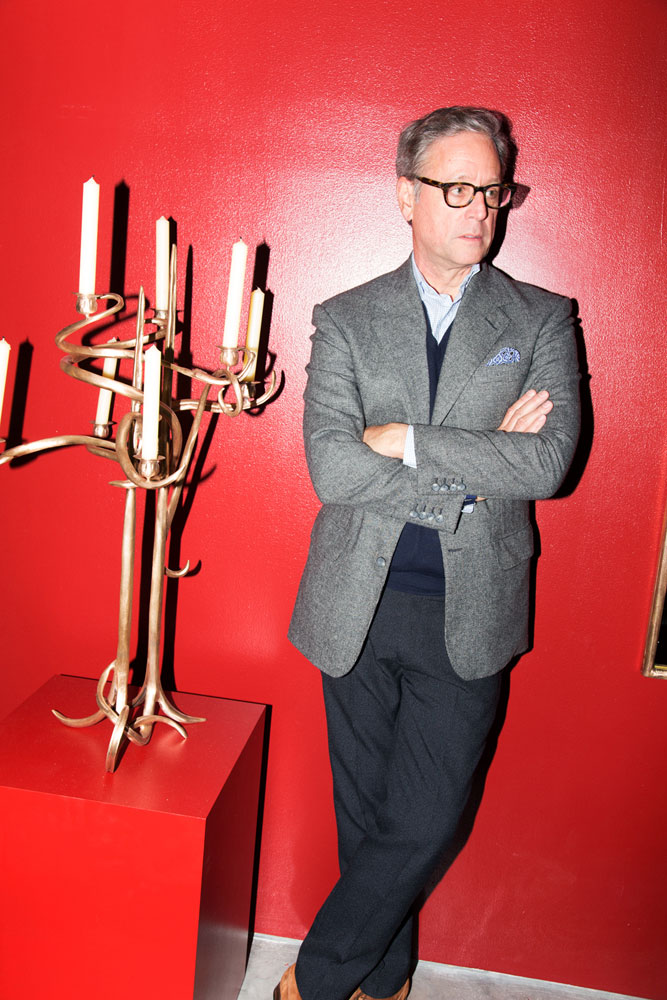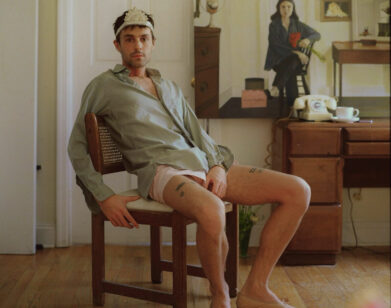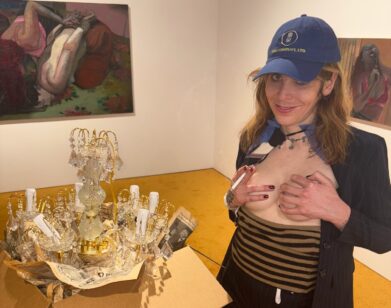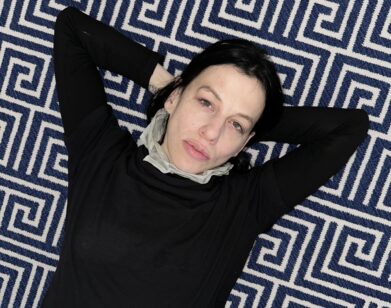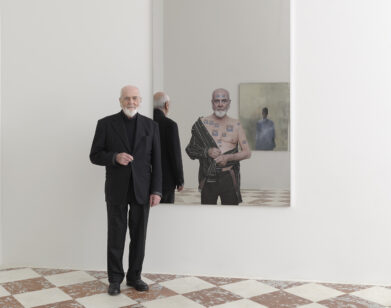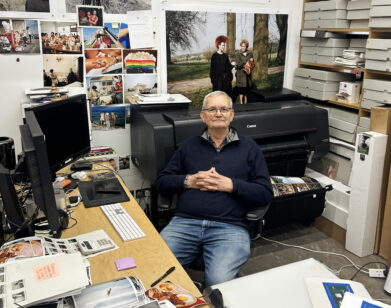A Garden in a Gallery
MADISON COX IN NEW YORK, MARCH 2015. PORTRAITS BY KATE OWEN.
A gallery and a garden: two spaces where most would not see parallels. But for Madison Cox, a renowned landscape designer with three flourishing decades of experience, the transition from the great outdoors to inside a white cube was seamless, if not purely logical.
For her latest show “Les Lalanne” at Paul Kasmin Gallery, the 91-year-old French artist Claude Lalanne and her longtime dealer wanted to display recent work alongside pieces by her late husband and collaborator, François-Xavier, in a new light. Kasmin approached Cox to design a unique layout, and he agreed. Claude and François-Xavier (known collectively as Les Lalanne), emerged during the 1960s and 1970s and quickly became recognized for their surrealist sculptures, which take inspiration directly from animal and plants—making them all the more suitable for Cox to envision a fantastical garden in a gallery setting. Over talks with Claude, Cox devised a simple and elegant “mini-labyrinth” in which to place the work, approaching the floor plan as he might a walkway through a garden. Preferring winding paths that slowly reveal the details of scenery, he created a trajectory for gallery visitors, demarcated by 10-foot-high walls, that allows them to gradually discover each work. Upon entering, viewers pass through a bronze gate titled Porte de Jardin (2015)—made by Claude especially for the installation—and must immediately turn left or right, determining in what order pieces appear to them. Eventually, they will come across striking bronzes, including Pomme d’Hiver (2014), a gigantic apple by Claude, and Wapiiti (grand) (2000), a life-size stag by François-Xavier. Beyond the labyrinth is a fairytale-like red room filled with candelabras and large mirrors, made by Claude in the last year. A peek behind the furthermost wall reveals Genie de Bellerive (Grand) Sur Pylone (2007), one of François-Xavier’s final works before his death in 2008.
Cox has been a friend and a devout admirer of Les Lalanne since meeting them in the late ’70s. We caught him on the phone the day after the opening, and asked him how it was. “I think Claude Lalanne was pleased. And so was Mr. Kasmin,” Cox said. “So, mission accomplished.”
RACHEL SMALL: I was reading how you have a reputation for being very attentive to the people you work with on respective projects. What was the process, and what were the challenges you dealt with designing the exhibition layout for “Les Lalanne”?
MADISON COX: This is a one-time thing, actually. Basically, it’s an installation, but it mimics everything else. I have [had] some conditions working with people and there is no dialogue, or very little. Those are sometimes the most frustrating or the more difficult projects. But the ones that I personally enjoy the most are when there is a dialogue with a client. That was what was so wonderful with Claude Lalanne, whose work I’ve known for decades now. I’ve know her on a friendship level. She’s done some pieces for a projects of mine, but we basically purchase pieces for clients, or clients have purchased pieces from her and we place them in the garden context. Not that I commissioned pieces for this exhibition, but I did sort of propose ideas, like the garden gates, [to strengthen] the idea of entering this labyrinth.
SMALL: How did this idea come about in the first place?
COX: When Kasmin called me and said that he was going to mount this exhibition, I said it would be interesting to see. It sounded like fun. It would be a challenge. I have a great affection and admiration for both of their works. [Claude] is no spring chicken; I’ve worked with a couple people who are close in age [to her], and there’s an enormous wealth of knowledge and vision. I thought that since so many of their pieces are iconic, and they’re so well known for certain people, the idea was to isolate the pieces as much as possible, so there would be a sense of discovery. Actually, I had created something that was tighter and messier–there were more divisions, with a path towards the center room, which was inspired by the famous Saint Laurent music room—that Claude wanted to produce. She’s been having fun producing mirrors of different shapes. So I thought, rather than placing these mirrors in different parts of the gallery, let’s join them together, and put them in a completely different context than the off-white walls of the rest of the space and cover it. And she’s incorporated candles in the mirrors. The idea was that you wander through this sequence of spaces, and then enter in the center of it, which is the red room. Beyond is the totem pole, François’s piece, among the last pieces he made before he died. The idea was this progression of different experiences from the gate to the lanterns to the apple to the gorilla, etcetera, then you’re finally in the red room, and then a little special surprise behind it.
SMALL: Both their work and gardens, which you have designed your whole life, have this mythical quality to it.
COX: Yes. Les Lalanne lived in this little village Ury, near Fontainebleau. It’s a house within a small little village, and in all those French villages they have a structure or building on the street, then a courtyard and the house. Going from one exterior space, there might be a wall, and you add a little doorway that goes into the exterior space, where she also cultivates all the plants that she uses in her sculptures. There is already that sense of a series of “gardens” in their workshops [in their homes]. His is now closed; she’s still there, soldering away. There was also that idea—I thought it would be more interesting to come into that large rectangular space of Kasmin gallery—to see everything up against the wall. What was gratifying was when I saw her Tuesday afternoon [before the opening], she said that this was the first time her work has been shown so that you’re actually focusing on the individual work, opposed to all the work read globally, all at once. She was very pleased with that.
SMALL: What other thoughts went into the layout? Obviously having the gate at the front is very charming.
COX: The idea also was to close off the space from the street view. I think it’s important in any kind of garden experience, especially in that context with these kind of works, [to] really create this sense of discovery and mystery.
SMALL: In your experience designing gardens, what sort of overlap was there creating a layout for a gallery? You mentioned this element of discovery, but what other concepts did you apply to design this space?
COX: I think there’s also that play on scale. Having all those walls be 10 feet tall, they’re dominant. There’s certain psychological feelings that one has walking through that rather narrow gateway. There’s also [the experience of] going from a very brightly lit space to a fairly darkened space, and going back again in the last room, which is lit artificially. That kind of experience [is] one that one can have also within the garden context. [Like] walking through from a forest or a glade to an open area, all those things I think heighten the experience.
SMALL: And still, you don’t know what’s going to be around the corner.
COX: I don’t know which way you walked in, but if you walked in and were to turn right, you go beyond the gates and see the giant owl. And then you turn right and left and you see the two lanterns on the pedestals and then the little table. And then you go around the corner and you discover the apple, and you go around that, and you discover something else. Most gardens, one would hope that there’s a personal experience, that one develops a relationship with the environment. I wanted to avoid something that would be similar to a large, open grass lawn, with everything dotted on the perimeter.
SMALL: It’s interesting to think how an exhibition design and a garden can overlap. And the experience of exploring either one. Because there are a lot of exhibitions where everything is right there in the open in the middle of the gallery.
COX: Yeah. Like plop art. Or something. You plop a big piece of sculpture and it sits there and everyone wanders around it and then they walk out.
SMALL: How do you see Les Lalanne’s relationship with nature and the experience of nature? They kind of imagine it in this surreal way. Have you ever been inspired by them?
COX: Well I think that they are a breed apart. People say their work is very surreal. But I think they are unique in [the context of the Surrealists]. They have been widely copied. What I do admire most is their integrity, in the sense that they have always been fascinated with the play of nature and the importance of nature. They’ve been true to themselves. And you know, at 91-years-old, she’s still fascinated; [she is] still going out and plucking up that hosta leaf and casting it in bronze. There’s this deep appreciation and valorization of the natural world. That’s what I find touching and moving—that they haven’t moved with fashions but fashions have moved with them. They’ve gone in and out of fashion. They were popular in the 1970s and then there was a low moment in a certain period in their lives, and they still remain true to themselves and produce what they were most passionate about and what they are trying to express. There’s also a sense of whimsy and playfulness about it, which is wonderful, I think.
SMALL: Does that overlap with your view of nature at all?
COX: Well, I think it overlaps more with the methodology in working, or in expressing. The methodology in creating something…as opposed to perhaps nature. As I said, what I admire most is how they remain true to themselves; that expression has always remained constant, in a sense. There’s quality in the workmanship, there’s craftsmanship. Her hands are so extraordinary. They’re so expressive. They’re calloused. They’re burnt. She’s out there soldering and welding. It’s not that she’s doing this all alone by herself. That’s what remarkable: To stay true to oneself through thick and thin. The times of wine and roses and the times when they probably weren’t doing as well.
SMALL: Reflecting now that the show has opened, what are your thoughts on the final outcome? What do you hope people will from it?
COX: I hope what people get out of it is to discover that world that those two have created, and created for themselves. I’ve been very lucky to go out to where they live, or where she lives now and where they lived as a couple. It’s bohemian, very modest, but extremely verified in that sense. There’s appreciation for life and doing things well. They are two artists, two creators. They created a world that they themselves inhabited and also were inspired by. You know, almost all the elements that she cast in bronze come from their garden. He was inspired by the donkeys he saw in the village, or by the frog in the garden, and so on, but then did wacky things with them if he wanted—like blowing them up, or [turning them into] a table, or a bar, or a sculpture.
They created a world amongst themselves that was unto themselves, and stayed faithful to that. I think that’s kind of remarkable. Hopefully with the layout of this exhibition, you have that sense of discovery, and [you feel like] you are entering into that magical world that’s very different from most of our lives and also adds whimsy and fantasy to it. You chuckle, or laugh, or giggle as you see something like the big gigantic apple as you come around the corner. Or the fairytale-like experience when you walk into the room with all those mirrors. [The layout makes you feel like you are] entering more into their world, opposed to walking into a space that’s more clinical, or colder, or in a museum-like context.
SMALL: What about that fairytale quality you mentioned?
COX: Les Lalanne are very serious about what they’re doing and what they’ve done and what they’ve produced. But I think there’s also a playful aspect to everything that they have done. Being playful or whimsical doesn’t mean it’s less serious, or less important. I think that they’ve created a world that’s very much theirs. I won’t say it’s childlike in the sense that it’s primary or it’s simple, but I think it’s highly respective of their vision of how one can live within this world.
LES LALANNE IS ON VIEW AT PAUL KASMIN GALLERY AT 515 WEST 27TH STREET THROUGH MAY 2, 2015.

